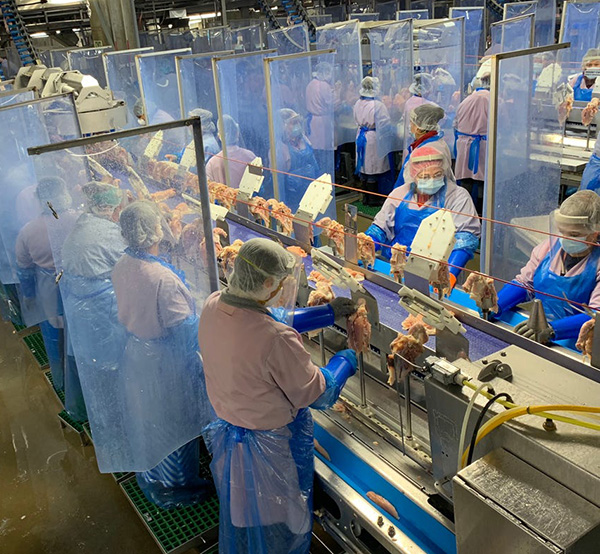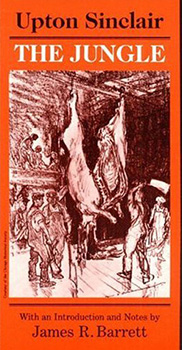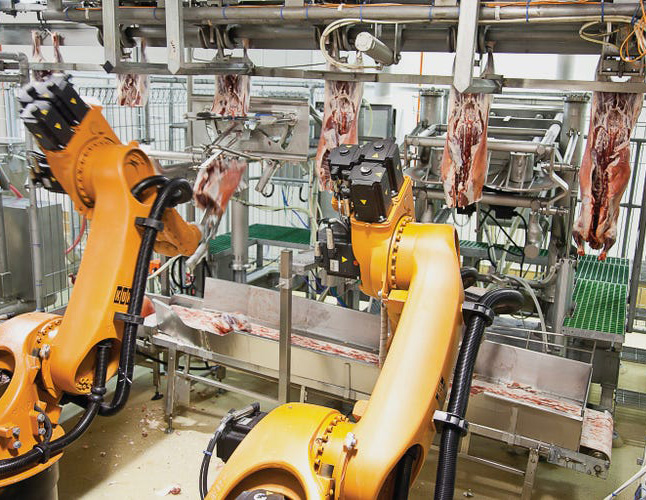

Automated Meat Processing Post-COVID
Humans in the loop is a virus time bomb. New-age infrastructure change is needed to secure the meat supply
Virus time bomb
The faster the line moves, the more people that are needed. The more people that are needed, the closer they are packed together. The closer they are packed together, the shorter the fuse gets for a viral or bacterial time bomb to ignite.

There’s something disturbing about looking at a group of people standing shoulder to shoulder all day on a meat production line each with a sharp knife in hand. It looks like hard work that’s dangerous and humiliating; and you’re glad you don’t have to work at it or anyone you know. Yet we all like to eat the product of their labors.
The authors of Traumatic injury rates in meatpacking plant workers put injuries per 100 workers at 25 to 33 percent, which partially bears out the disturbing feel that one gets from looking at most any meat production line. It’s dangerous!
The Centers for Disease Control and Prevention (CDC) estimate that 1 in 6 Americans is annually sickened from contaminated foods—3,000 die. The U.S. Department of Agriculture (USDA) estimates that foodborne illnesses cost more than $15.6 billion each year. The points of origination for the majority of such illnesses are most always at the plant level.

Without too much of a leap of imagination, most anyone would conclude that meat production is most definitely a place strictly meant for automation and robots. Especially so, given its place of importance from everyone’s dinner table to the country’s economic vitality. Analysis from John Dunham & Associates puts the U.S. meat and poultry industry at $1.02 trillion in total economic output, or 5.6 percent of the country’s gross domestic product (GDP).
So, meat and poultry is not some unknown, niche industry that’s easily overlooked as a target for modernization, nor camouflaged sweat shops laboring over pricey athletic shoes. Meat and poultry is a mega industry, but, until its recent unmasking because of COVID, was obviously hidden far from scrutiny.
And since there is plenty of robot tech and automation gear already in the marketplace that can do all of those unsavory, dangerous, and degrading jobs, with equal skill and better speed, there’s really no legit excuse why robots aren’t the country’s favored butchers.
Does enlightenment take a tragedy?
 Upton Sinclair’s 1906 novel The Jungle, about the harsh conditions and exploited lives of immigrants in the horrendously unsanitary meat plants of turn-of-the-century Chicago, helped to precipitate The Pure Food and Drug Act as well as The Federal Meat Inspection Act, both of 1906
Upton Sinclair’s 1906 novel The Jungle, about the harsh conditions and exploited lives of immigrants in the horrendously unsanitary meat plants of turn-of-the-century Chicago, helped to precipitate The Pure Food and Drug Act as well as The Federal Meat Inspection Act, both of 1906
Seems COVID is similarly positioned to have a major effect on meat packing modernization. Illuminating further, so to speak, what The Jungle first exposed over a hundred years previous.
COVID isn’t some alien plague from outer space; our animals pass it along to us. Swine flu from pigs, Bird flu from poultry, MERS from camels. Did no one ever entertain the notion that any of these viruses could devastate the meat packing industry…and the people working in it?
Should it be a surprise that COVID (also from an animal) has affected every meat packing plant in the U.S.? According to the CDC (10 July 2020): the totals (for April and May) were 239 meat packing facilities in 23 states showing 16,233 cases of COVID, including 86 related deaths. Barren meat counters in most every supermarket left people scrambling for substitutes.
Frigid air, close quarters
So why would meatpacking plants be such a good choice for substituting human labor with that of robots? A recent article, Why Meatpacking Plants Have Become Covid-19 Hot Spots, throws a bit of logical deduction at the issue. The virus transmission similarity between meat packing plants, prisons, long-term care facilities, homeless shelters, and cruise ships, says the article, easily attest to the fact that, “If you stick a bunch of people in close quarters for long periods of time, the virus will inevitably spread.” And indeed, all of the aforementioned “close-quarter” places have been COVID hot spots.
However, different from all the other groups in close quarters, only the meat packers are working hard and breathing heavy as they contend with thousands of animal carcasses. Most of that heavy breathing is performed in frigid temperatures where viruses thrive, in cramped conditions, over long hours, with cold air circulating through large, open processing rooms, where “industry averages ranging from 1,000 animals per hour in pork processing to over 8,000 per hour in chicken plants” need to be rapidly handled one after another.
If that’s not reason enough OSHA, the Occupational Safety and Health Administration, lards on additional hazards: exposure to high noise levels, dangerous equipment, slippery floors, musculoskeletal disorders, hazardous chemicals (including ammonia that is used as a refrigerant), exposure to biological risks associated with handling live animals or exposures to feces and blood which can increase their risk for many diseases.
In the U.S., the numbers of people in direct meat processing jobs are nearly 200,000. In 2019, wages averaged $14.13 per hour or $29,400 yearly. With some 220 processing plants in the U.S., the average is about 900 workers per plant. Substituting robots and automation for those 200,000 means absorbing the workers into the unemployment system ($6B), and then finding new jobs or retraining the workers. In view of the financial damage that COVID has wrought in five months of rampaging throughout the world, plus the uncertain virus-spreading future of meat processing plants going forward, the price is cheap. Added to that the billions of dollars in automating the industry; also, cheap.
What’s needed, and what really hasn’t happened since The Jungle, is a new concept for infrastructure in meat processing. Blink at most any processing line and it could easily be 1970 or 1950. Real change has been glacial. Sure, the industry has gone digital, but not by enough. Meat processing robots and automated processing machinery are plentifully available, but no one has been really looking at them until COVID came along.
Maybe the best and fastest resolution might well be to take humans out of the loop entirely…and as quickly as possible. Before too long, one or more of our other animals will most surely present with a new or renewed virus. Keeping it away from the food chain should be one of the highest priorities.

